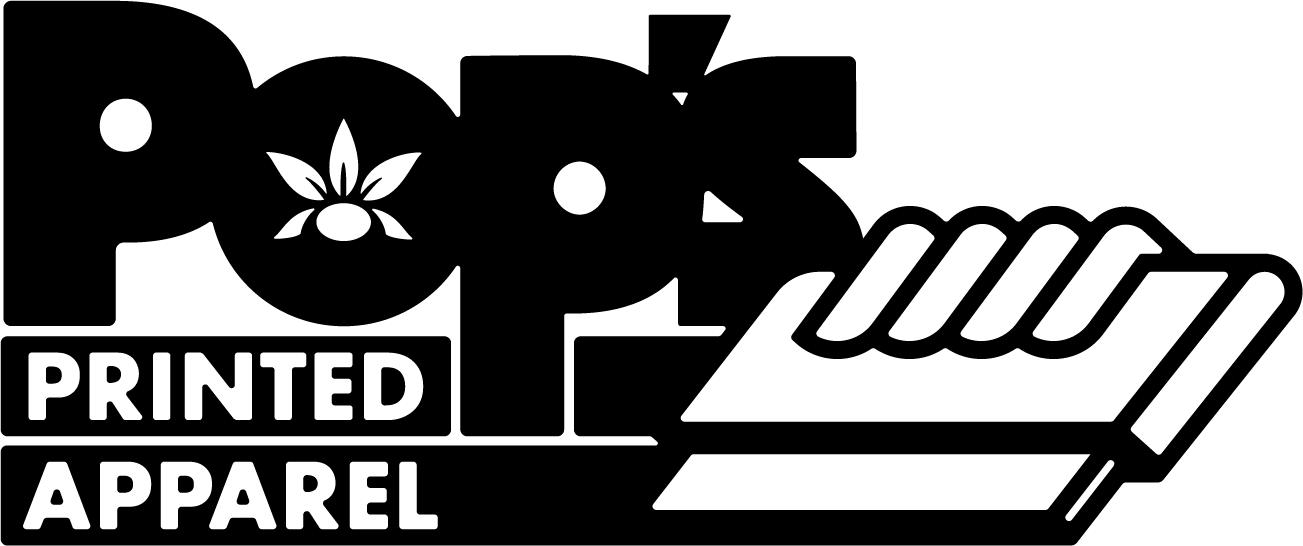Printing Methods
At Pop's, we offer five primary embellishment methods based on the results you're looking for.
Plastisol printing
A traditional method of screen printing, Plastisol printing is the use of a PVC-based Plastisol ink that is directly adhered to a garment and then cured at a high temperature to dry and harden. Here's what you need to know about Plastisol Printing:
Plastisol can be printed on a wide range of fabric types, including but not limited to: Cotton, Polyester, Nylon, Lyrcra, and Spandex
Plastisol can be printed on both light and colored garments
Upon printing, Plastisol results in a medium, slightly raised hand (hand is the feel of the dried ink on the garment)
Plastisol ink stays true to color upon drying, and can be Pantone Color matched if you're in need of an exact color
Discharge printing
Discharge printing is a method of printing in which ink is soaked into the fabric fibers of a garment. A chemical reaction takes place removing the original dyed color of the shirt, then the fibers are re-dyed to the desired design color. Here's what you should know:
Discharge inks yield the best results with 100% Cotton garments
Discharge ink is intended to be used with dark colored garments
Upon printing, discharge ink yields little to no hand (hand is the feel of the dried ink on the garment) after washing because it is physically dyed into the garment's fibers
Discharge inks do not stay as true to color as Plastisol inks, as the actual color of the cotton varies from garment to garment. With certain colored garments, printed designs may slightly tint to the color of the fabric.
When combined with heathered garments, Discharge Printing yields a vintage, worn-in look
WaterBased Printing
Waterbased printing is a method of printing that is very similar to discharge when talking about the final feel of the printed design. With waterbased printing, the ink better penetrates and dyes the fibers of the shirt, rather than sit on top of the fabric like plastisol. Here are some things you should know:
The best results come when mixing water-based inks with 100% Cotton garments
Because the ink does not remove the original dye, the ink tends to blend with the color of the shirt. It is highly recommended to use white or light colored shirts
If you want to achieve a faded/vintage look dark shirts and water-based inks are a viable option
Upon printing, water-based inks are very "breathable" and yield little to no hand after the garments have been washed
Water-based colors blend with the fibers of the shirt so depending on the color of your garment, the color of your ink can change from its true color
CMYK 4 color process Printing
CMYK Printing is the process in which four ink colors; cyan, magenta, yellow, and black, are printed one on top of the other to achieve a full color print. Some things to note include:
This is the process to use if you have a full color design or a photograph
This process is done best on white, natural, or light grey garments.
These inks are water-based so they too yield little to no hand
Vinyl heat transfer
Vinyl Heat Transfer is a method where a design is physically cut out of a vinyl transfer material, then pressed into a garment with high heat and pressure. Here's what you should know about Vinyl Heat Transfers:
Vinyl Heat Transfer is an excellent low-cost alternative to Plastisol printing for small orders
Vinyl Heat Transfer is used for printing names and numbers on team jerseys
Upon application, Vinyl Heat Transfers yield a heavier hand, meaning you can physically feel the design on the garment

